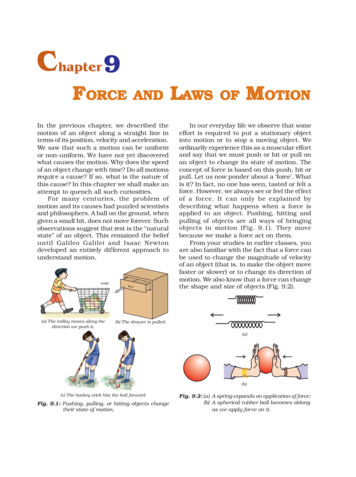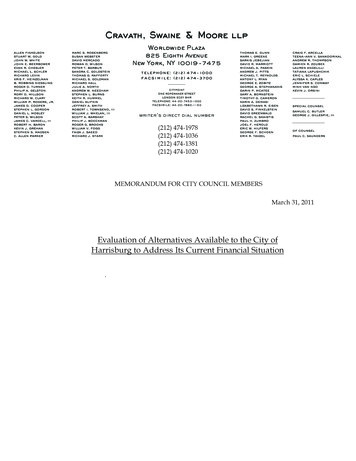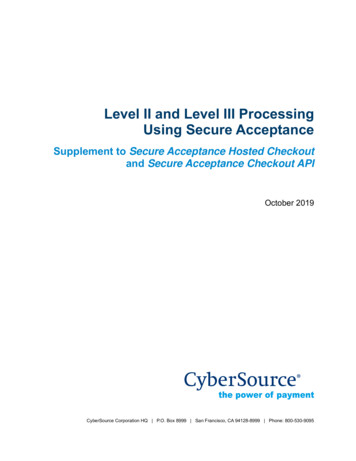
Transcription
CHAPTER9Accounting forReceivablesStudy ObjectivesAfter studying this chapter, you should be able to:[1] Identify the different types of receivables.[2] Explain how companies recognize accountsreceivable.[3] Distinguish between the methods and basescompanies use to value accounts receivable.[4] Describe the entries to record the dispositionof accounts receivable.[5] Compute the maturity date of and interest onnotes receivable.[6] Explain how companies recognize notesreceivable.Feature StoryA DOSE OF CAREFUL MANAGEMENTKEEPS RECEIVABLES HEALTHYApago PDF “SometimesEnhanceryou have to know when to be[7] Describe how companies value notes receivable.[8] Describe the entries to record the dispositionof notes receivable.[9] Explain the statement presentation andanalysis of receivables. [The Navigator] [The Navigator] Scan Study Objectives Read Feature Story Read Preview Read text and answer Do it! p. 425 p. 427 p. 433 p. 434 Work Comprehensive Do it! p. 435 Review Summary of Study Objectives Answer Self-Test Questions Complete Assignments Go to WileyPLUS for practice and tutorials Read A Look at IFRS p. 453 414very tough, and sometimes you can givethem a bit of a break,” says Vivi Su. She’snot talking about her children, but aboutthe customers of a subsidiary of pharmaceutical company Whitehall-Robins, where sheworks as supervisor of credit and collections.For example, while the company’s regularterms are 1/15, n/30 (1% discount if paidwithin 15 days), a customer might ask forand receive a few days of grace and still getthe discount. Or a customer might placeorders above its credit limit, in which case,depending on its payment history and thecircumstances, Ms. Su might authorizeshipment of the goods anyway.“It’s not about drawing a line in the sand,and that’s all,” she explains. “You want agood relationship with your customers—butyou also need to bring in the money.”
“The money,” in Whitehall-Robins’scase, amounts to some 170 millionin sales a year. Nearly all of it comesin through the credit accounts Ms.Su manages. The process starts withthe decision to grant a customeran account in the first place, Ms. Su explains. The sales rep gives the customer a credit application.“My department reviews this application very carefully; a customer needs to supply three goodreferences, and we also run a check with a credit firm like Equifax. If we accept them, thenbased on their size and history, we assign a credit limit.”Once accounts are established, the company supervises them very carefully. “I get an agingreport every single day,” says Ms. Su.“The rule of thumb is that we should always have at least 85% of receivables current—meaningthey were billed less than 30 days ago,” she continues. “But we try to do even better thanthat—I like to see 90%.” Similarly, her guideline is never to have more than 5% of receivablesat over 90 days. But long before that figure is reached, “we jump on it,” she says firmly.At 15 days overdue, Whitehall-Robins phones the client. Often there’s a reasonable explanationfor the delay—an invoice may have gone astray, or the payables clerk is away. “But if a customerkeeps on delaying, and tells us several times that it’ll only be a few more days, we know there’sa problem,” says Ms. Su. After 45 days, “I send a letter. Then a second notice is sent in writing.After the third and final notice, the client has 10 days to pay, and then I hand it over to acollection agency, and it’s out of my hands.”Apago PDF EnhancerMs. Su’s boss, Terry Norton, records an estimate for bad debts every year, based on a percentage ofreceivables. The percentage depends on the current aging history. He also calculates and monitorsthe company’s receivables turnover ratio, which the company reports in its financial statements.“I think of it in terms of collection period of DSO—days of sales outstanding,” he explains.Ms. Su knows that she and Mr. Norton are crucial to the profitability of Whitehall-Robins.“Receivables are generally the second-largest asset of any company (after its capital assets),”she points out. “So it’s no wonder we keep a very close eye on them.” [The Navigator]InsideCHAPTER9 Anatomy of a Fraud (p. 418) Accounting Across the Organization: How Does a Credit Card Work? (p. 427) International Insight: Can Fair Value Be Unfair? (p. 430) Accounting Across the Organization: Bad Information Can Lead to Bad Loans (p. 432)415
PreviewofCHAPTER9As indicated in the Feature Story, receivables are a significant asset for many pharmaceutical companies.Because a significant portion of sales in the United States are done on credit, receivables are significantto companies in other industries as well. As a consequence, companies must pay close attention to theirreceivables and manage them carefully. In this chapter you will learn what journal entries companiesmake when they sell products, when they collect cash from those sales, and when they write off accountsthey cannot collect.The content and organization of the chapter are as follows.Accounting for ReceivablesTypes of Receivables Accounts receivable Notes receivable Other receivablesAccounts ReceivableNotes Receivable Recognizing accountsreceivable Valuing accounts receivable Disposing of accountsreceivable Determining maturity date Computing interest Recognizing notes receivable Valuing notes receivable Disposing of notes receivableStatement Presentationand Analysis Presentation Analysis [The Navigator]Types of ReceivablesStudy Objective [1]Identify the differenttypes of receivables.Illustration 9-1Receivables as a percentageof assetsApago PDF EnhancerThe term receivables refers to amounts due from individuals and companies.Receivables are claims that are expected to be collected in cash. The managementof receivables is a very important activity for any company that sells goods orservices on credit.Receivables are important because they represent one of a company’s mostliquid assets. For many companies, receivables are also one of the largest assets. Forexample, receivables represented 30.8% of the current assets of pharmaceuticalgiant Rite Aid in 2009. Illustration 9-1 lists receivables as a percentage of totalassets for five other well-known companies in a recent year.CompanyGeneral ElectricFord Motor CompanyMinnesota Mining and Manufacturing Company(3M)DuPont Co.Intel CorporationReceivables as aPercentage of Total Assets52%42%14%17%5%The relative significance of a company’s receivables as a percentage of its assetsdepends on various factors: its industry, the time of year, whether it extends longterm financing, and its credit policies. To reflect important differences amongreceivables, they are frequently classified as (1) accounts receivable, (2) notesreceivable, and (3) other receivables.Accounts receivable are amounts customers owe on account. They result fromthe sale of goods and services. Companies generally expect to collect accountsreceivable within 30 to 60 days. They are usually the most significant type of claimheld by a company.416
Accounts ReceivableNotes receivable represent claims for which formal instruments of creditare issued as evidence of the debt. The credit instrument normally requiresthe debtor to pay interest and extends for time periods of 60–90 days orlonger. Notes and accounts receivable that result from sales transactions areoften called trade receivables.Other receivables include nontrade receivables such as interest receivable, loans to company officers, advances to employees, and income taxesrefundable. These do not generally result from the operations of the business. Therefore, they are generally classified and reported as separate itemsin the balance sheet.417Ethics NoteCompanies report receivablesfrom employees separately in thefinancial statements. The reason:Sometimes those assets are notthe result of an “arm’s-length”transaction.Accounts ReceivableThree accounting issues associated with accounts receivable are:1. Recognizing accounts receivable.2. Valuing accounts receivable.3. Disposing of accounts receivable.Recognizing Accounts ReceivableStudy Objective [2]Recognizing accounts receivable is relatively straightforward. A service organizationExplain how companiesrecords a receivable when it provides service on account. A merchandiser recordsrecognize accountsaccounts receivable at the point of sale of merchandise on account. When a merreceivable.chandiser sells goods, it increases (debits) Accounts Receivable and increases(credits) Sales Revenue.The seller may offer terms that encourage early payment by providinga discount. Sales returns also reduce receivables. The buyer might findEthics Notesome of the goods unacceptable and choose to return the unwantedgoods.In exchange for lower interestTo review, assume that Jordache Co. on July 1, 2012, sells merchandise rates, some companies haveon account to Polo Company for 1,000, terms 2/10, n/30. On July 5, Polo eliminated the 25-day gracereturns merchandise worth 100 to Jordache Co. On July 11, Jordache re- period before finance chargesceives payment from Polo Company for the balance due. The journal entries kick in. Be sure you read the fineto record these transactions on the books of Jordache Co. are as follows. print in any credit agreement yousign.(Cost of goods sold entries are omitted.)Apago PDF EnhancerJuly 1July 5July 11Accounts Receivable—Polo CompanySales Revenue(To record sales on account)1,0001,000Helpful HintSales Returns and AllowancesAccounts Receivable—Polo Company(To record merchandise returned)100Cash ( 900 2 18)Sales Discounts ( 900 3 .02)Accounts Receivable—Polo Company(To record collection of accounts receivable)88218100900Some retailers issue their own credit cards. When you use a retailer’s creditcard (JCPenney, for example), the retailer charges interest on the balance due if notpaid within a specified period (usually 25–30 days).These entries are the sameas those described inChapter 5. For simplicity,we have omitted inventoryand cost of goods soldfrom this set of journalentries and from end-ofchapter material.
418A13009 Accounting for Receivables5L1To illustrate, assume that you use your JCPenney Company credit card to purchase clothing with a sales price of 300. JCPenney will increase (debit) AccountsReceivable for 300 and increase (credit) Sales Revenue for 300 (cost of goodssold entry omitted) as follows.OE1300 RevCash Flowsno effectA14.505L1Accounts ReceivableSales Revenue(To record sale of merchandise)300300Assuming that you owe 300 at the end of the month, and JCPenney charges 1.5%per month on the balance due, the adjusting entry that JCPenney makes to recordinterest revenue of 4.50 ( 300 3 1.5%) is as follows.OE14.50 RevCash Flowsno effectAccounts ReceivableInterest Revenue(To record interest on amount due)4.504.50Interest revenue is often substantial for many retailers.ANATOMY OF A FRAUDTasanee was the accounts receivable clerk for a large non-profit foundation thatprovided performance and exhibition space for the performing and visual arts. Herresponsibilities included activities normally assigned to an accounts receivable clerk,such as recording revenues from various sources that included donations, facilityrental fees, ticket revenue, and bar receipts. However, she was also responsible forhandling all cash and checks from the time they were received until the time shedeposited them, as well as preparing the bank reconciliation. Tasanee took advantage of her situation by falsifying bank deposits and bank reconciliations so that shecould steal cash from the bar receipts. Since nobody else logged the donations ormatched the donation receipts to pledges prior to Tasanee receiving them, she wasable to offset the cash that was stolen against donations that she received but didn’trecord. Her crime was made easier by the fact that her boss, the company’s controller,only did a very superficial review of the bank reconciliation and thus didn’t noticethat some numbers had been cut out from other documents and taped onto thebank reconciliation.Apago PDF EnhancerTotal take: 1.5 millionTHE MISSING CONTROLSegregation of duties. The foundation should not have allowed an accounts receivable clerk, whose job was to record receivables, to also handle cash, record cash,make deposits, and especially prepare the bank reconciliation.Independent internal verification. The controller was supposed to perform a thorough review of the bank reconciliation. Because he did not, he was terminatedfrom his position.Source: Adapted from Wells, Fraud Casebook (2007), pp. 183–194.Study Objective [3]Distinguish betweenthe methods and basescompanies use to valueaccounts receivable.Valuing Accounts ReceivableOnce companies record receivables in the accounts, the next question is: Howshould they report receivables in the financial statements? Companies report accounts receivable on the balance sheet as an asset. But determining the amount toreport is sometimes difficult because some receivables will become uncollectible.
Accounts ReceivableEach customer must satisfy the credit requirements of the seller before thecredit sale is approved. Inevitably, though, some accounts receivable become uncollectible. For example, a customer may not be able to pay because of a declinein its sales revenue due to a downturn in the economy. Similarly, individuals maybe laid off from their jobs or faced with unexpected hospital bills. Companiesrecord credit losses as debits to Bad Debts Expense (or Uncollectible AccountsExpense). Such losses are a normal and necessary risk of doing business on acredit basis.Recently, when U.S. home prices fell, home foreclosures rose, and the economyin general slowed, lenders experienced huge increases in their bad debts expense.For example, during a recent quarter Wachovia, the fourth largest U.S. bank, increased bad debts expense from 108 million to 408 million. Similarly, AmericanExpress increased its bad debts expense by 70%.Two methods are used in accounting for uncollectible accounts: (1) the directwrite-off method and (2) the allowance method. The following sections explainthese methods.Alternative TerminologyYou will sometimes seeBad Debts Expense calledUncollectible AccountsExpense.DIRECT WRITE-OFF METHOD FOR UNCOLLECTIBLE ACCOUNTSUnder the direct write-off method, when a company determines a particular account to be uncollectible, it charges the loss to Bad Debts Expense. Assume, forexample, that Warden Co. writes off as uncollectible M. E. Doran’s 200 balance onDecember 12. Warden’s entry is:ADec. 12Bad Debts ExpenseAccounts Receivable—M. E. Doran(To record write-off of M. E. Doran account)200Apago PDF Enhancer20052200L1 OE2200 ExpCash Flowsno effectUnder this method, Bad Debts Expense will show only actual losses fromuncollectibles. The company will report accounts receivable at its gross amount.Although this method is simple, its use can reduce the usefulness of both theincome statement and balance sheet. Consider the following example. Assumethat in 2012, Quick Buck Computer Company decided it could increase its revenues by offering computers to college students without requiring any moneydown and with no credit-approval process. On campuses across the country, itdistributed one million computers with a selling price of 800 each. This increasedQuick Buck’s revenues and receivables by 800 million. The promotion was ahuge success! The 2012 balance sheet and income statement looked great. Unfortunately, during 2013, nearly 40% of the customers defaulted on their loans. Thismade the 2013 income statement and balance sheet look terrible. Illustration 9-2shows the effect of these events on the financial statements if the direct write-offmethod is used.Year 2012NetincomeHuge sales promotion.Sales increase dramatically.Accounts receivable increases dramatically.Year 2013NetincomeCustomers default on loans.Bad debts expense increases dramatically.Accounts receivable plummets.419Illustration 9-2Effects of direct write-offmethod
4209 Accounting for ReceivablesUnder the direct write-off method, companies often record bad debts expensein a period different from the period in which they record the revenue. The methoddoes not attempt to match bad debts expense to sales revenues in the income statement. Nor does the direct write-off method show accounts receivable in the balance sheet at the amount the company actually expects to receive. Consequently,unless bad debts losses are insignificant, the direct write-off method is not acceptable for financial reporting purposes.ALLOWANCE METHOD FOR UNCOLLECTIBLE ACCOUNTSThe allowance method of accounting for bad debts involves estimating uncollectible accounts at the end of each period. This provides better matching on the income statement. It also ensures that companies state receivables on the balancesheet at their cash (net) realizable value. Cash (net) realizable value is the netamount the company expects to receive in cash. It excludes amounts that the company estimates it will not collect. Thus, this method reduces receivables in the balance sheet by the amount of estimated uncollectible receivables.GAAP requires the allowance method for financial reporting purposes whenbad debts are material in amount. This method has three essential features:Helpful HintIn this context, materialmeans significant orimportant to financialstatement users.1. Companies estimate uncollectible accounts receivable. They match this estimated expense against revenues in the same accounting period in which theyrecord the revenues.2. Companies debit estimated uncollectibles to Bad Debts Expense and creditthem to Allowance for Doubtful Accounts through an adjusting entry at theend of each period. Allowance for Doubtful Accounts is a contra account toAccounts Receivable.3. When companies write off a specific account, they debit actual uncollectiblesto Allowance for Doubtful Accounts and credit that amount to AccountsReceivable.Apago PDF EnhancerA5L212,0001 OE212,000 ExpCash Flowsno effectHelpful HintCash realizable value issometimes referred to asaccounts receivable (net).Recording Estimated Uncollectibles. To illustrate the allowance method, assume that Hampson Furniture has credit sales of 1,200,000 in 2012. Of this amount, 200,000 remains uncollected at December 31. The credit manager estimates that 12,000 of these sales will be uncollectible. The adjusting entry to record the estimated uncollectibles increases (debits) Bad Debts Expense and increases (credits)Allowance for Doubtful Accounts, as follows.Dec. 31Bad Debts ExpenseAllowance for Doubtful Accounts(To record estimate of uncollectibleaccounts)12,00012,000Hampson reports Bad Debts Expense in the income statement as an operating expense (usually as a selling expense). Thus, the estimated uncollectibles are matchedwith sales in 2012. Hampson records the expense in the same year it made the sales.Allowance for Doubtful Accounts shows the estimated amount of claims oncustomers that the company expects will become uncollectible in the future.Companies use a contra account instead of a direct credit to Accounts Receivablebecause they do not know which customers will not pay. The credit balance inthe allowance account will absorb the specific write-offs when they occur. AsIllustration 9-3 shows, the company deducts the allowance account from accountsreceivable in the current assets section of the balance sheet.The amount of 188,000 in Illustration 9-3 represents the expected cash realizable value of the accounts receivable at the statement date. Companies do not closeAllowance for Doubtful Accounts at the end of the fiscal year.
Accounts ReceivableIllustration 9-3Presentation of allowancefor doubtful accountsHampson FurnitureBalance Sheet (partial)Current assetsCashAccounts receivableLess: Allowance for doubtful accountsInventorySuppliesTotal current assets 14,800 200,00012,000188,000310,00025,000 537,800Recording the Write-Off of an Uncollectible Account. As described in theFeature Story, companies use various methods of collecting past-due accounts, suchas letters, calls, and legal action. When they have exhausted all means of collecting apast-due account and collection appears impossible, the company should write offthe account. In the credit card industry, for example, it is standard practice to writeoff accounts that are 210 days past due. To prevent premature or unauthorized writeoffs, authorized management personnel should formally approve each write-off. Tomaintain good internal control, companies should not authorize someone to writeoff accounts who also has daily responsibilities related to cash or receivables.To illustrate a receivables write-off, assume that the financial vice president ofHampson Furniture authorizes a write-off of the 500 balance owed by R. A. Wareon March 1, 2013. The entry to record the write-off is:Mar. 1Allowance for Doubtful AccountsAccounts Receivable—R. A. Ware(Write-off of R. A. Ware account)500Apago PDF Enhancer500A150025005L1Cash Flowsno effectBad Debts Expense does not increase when the write-off occurs. Under theallowance method, companies debit every bad debt write-off to the allowanceaccount rather than to Bad Debts Expense. A debit to Bad Debts Expense wouldbe incorrect because the company has already recognized the expense when itmade the adjusting entry for estimated bad debts. Instead, the entry to record thewrite-off of an uncollectible account reduces both Accounts Receivable and Allowance for Doubtful Accounts. After posting, the general ledger accounts will appearas in Illustration 9-4.Accounts ReceivableJan. 1 Bal. 200,000Mar. 1Allowance for Doubtful Accounts500421Mar. 1Mar. 1 Bal. 199,500500Jan. 1 Bal.12,000Mar. 1 Bal.11,500Illustration 9-4General ledger balancesafter write-offA write-off affects only balance sheet accounts—not income statement accounts.The write-off of the account reduces both Accounts Receivable and Allowance forDoubtful Accounts. Cash realizable value in the balance sheet, therefore, remainsthe same, as Illustration 9-5 shows.Before Write-OffAfter Write-OffAccounts receivableAllowance for doubtful accounts 200,00012,000 199,50011,500Cash realizable value 188,000 188,000Illustration 9-5Cash realizable valuecomparisonOE
4229 Accounting for ReceivablesRecovery of an Uncollectible Account. Occasionally, a company collects froma customer after it has written off the account as uncollectible. The company makestwo entries to record the recovery of a bad debt: (1) It reverses the entry made inwriting off the account. This reinstates the customer’s account. (2) It journalizes thecollection in the usual manner.To illustrate, assume that on July 1, R. A. Ware pays the 500 amount thatHampson had written off on March 1. Hampson makes these entries:A150025005L1OE(1)Accounts Receivable—R. A. WareAllowance for Doubtful Accounts(To reverse write-off of R. A. Wareaccount)July 1Cash Flowsno effectA150025005L1OE500500(2)CashAccounts Receivable—R. A. Ware(To record collection from R. A. Ware)July 1Cash Flows1500500500Note that the recovery of a bad debt, like the write-off of a bad debt, affectsonly balance sheet accounts. The net effect of the two entries above is a debit toCash and a credit to Allowance for Doubtful Accounts for 500. Accounts Receivable and the Allowance for Doubtful Accounts both increase in entry (1) for tworeasons: First, the company made an error in judgment when it wrote off the accountreceivable. Second, after R. A. Ware did pay, Accounts Receivable in the generalledger and Ware’s account in the subsidiary ledger should show the collection forpossible future credit purposes.Apago PDF EnhancerEstimating the Allowance. For Hampson Furniture in Illustration 9-3, theamount of the expected uncollectibles was given. However, in “real life,” companiesmust estimate that amount when they use the allowance method. Two bases areused to determine this amount: (1) percentage of sales, and (2) percentage ofreceivables. Both bases are generally accepted. The choice is a management decision.It depends on the relative emphasis that management wishes to give to expensesand revenues on the one hand or to cash realizable value of the accounts receivableon the other. The choice is whether to emphasize income statement or balancesheet relationships. Illustration 9-6 compares the two bases.Illustration 9-6Comparison of bases forestimating uncollectiblesSalesPercentage of SalesPercentage of ReceivablesMatchingCash Realizable ValueBad DebtsExpenseEmphasis on Income orDoubtfulAccountsEmphasis on Balance SheetRelationships
Accounts Receivable423The percentage-of-sales basis results in a better matching of expenses withrevenues—an income statement viewpoint. The percentage-of-receivables basisproduces the better estimate of cash realizable value—a balance sheet viewpoint.Under both bases, the company must determine its past experience with bad debtlosses.Percentage-of-Sales. In the percentage-of-sales basis, management estimates what percentage of credit sales will be uncollectible. This percentage is basedon past experience and anticipated credit policy.The company applies this percentage to either total credit sales or net creditsales of the current year. To illustrate, assume that Gonzalez Company elects to usethe percentage-of-sales basis. It concludes that 1% of net credit sales will becomeuncollectible. If net credit sales for 2012 are 800,000, the estimated bad debtsexpense is 8,000 (1% 3 800,000). The adjusting entry is:ADec. 31Bad Debts ExpenseAllowance for Doubtful Accounts(To record estimated bad debts for year)58,0008,00028,000L1 OE28,000 ExpCash Flowsno effectAfter the adjusting entry is posted, assuming the allowance account already hasa credit balance of 1,723, the accounts of Gonzalez Company will show thefollowing:Bad Debts ExpenseDec. 31 Adj.8,000Allowance for Doubtful AccountsJan. 1 Bal.Dec. 31 Adj.Apago PDF EnhancerDec. 31 Bal.1,7238,0009,723This basis of estimating uncollectibles emphasizes the matching of expenseswith revenues. As a result, Bad Debts Expense will show a direct percentage relationship to the sales base on which it is computed. When the company makes theadjusting entry, it disregards the existing balance in Allowance for DoubtfulAccounts. The adjusted balance in this account should be a reasonable approximation of the realizable value of the receivables. If actual write-offs differ significantly from the amount estimated, the company should modify the percentage forfuture years.Percentage-of-Receivables. Under the percentage-of-receivables basis,management estimates what percentage of receivables will result in losses fromuncollectible accounts. The company prepares an aging schedule, in which itclassifies customer balances by the length of time they have been unpaid.Because of its emphasis on time, the analysis is often called aging the accountsreceivable. In the Feature Story, Whitehall-Robins prepared an aging reportdaily.After the company arranges the accounts by age, it determines the expectedbad debt losses. It applies percentages based on past experience to the totals ineach category. The longer a receivable is past due, the less likely it is to be collected.Thus, the estimated percentage of uncollectible debts increases as the number ofdays past due increases. Illustration 9-8 (page 424) shows an aging schedule forDart Company. Note that the estimated percentage uncollectible increases from 2 to40% as the number of days past due increases.Illustration 9-7Bad debts accounts afterposting
4249 Accounting for ReceivablesIllustration 9-8Aging ul HintThe older categories havehigher percentagesbecause the longer anaccount is past due, theless likely it is to becollected.InsertBCustomerT. E. AdertR. C. BortzB. A. CarlO. L. DikerT. O. EbbetOthersEstimatedPercentageUncollectible12 Total EstimatedBad Debts13Total 60030045070060036,950 39,600FormatToolsCWindowDNotYet Due DataEHelpFGNumber of Days Past Due1–30 30031– 6061–90 200Over 90 100300200 25026,200 27,0005,200 5,7003002,450 3,0001,600 2,0003001,500 1,9002%4%10%20%40% 228 300 400 76050020011 2,228 540Total estimated bad debts for Dart Company ( 2,228) represent the amountof existing customer claims the company expects will become uncollectible in thefuture. This amount represents the required balance in Allowance for DoubtfulAccounts at the balance sheet date. The amount of the bad debt adjusting entryis the difference between the required balance and the existing balance in theallowance account. If the trial balance shows Allowance for Doubtful Accountswith a credit balance of 528, the company will make an adjusting entry for 1,700( 2,228 2 528), as shown here.Apago PDF EnhancerA521,700L1 OE21,700 ExpDec. 31Bad Debts ExpenseAllowance for Doubtful Accounts(To adjust allowance account to totalestimated uncollectibles)Cash Flowsno effect1,7001,700After Dart posts its adjusting entry, its accounts will appear as follows.Illustration 9-9Bad debts accounts afterpostingBad Debts ExpenseDec. 31 Adj.1,700Allowance for Doubtful AccountsBal.Dec. 31 Adj.5281,700Bal.2,228Occasionally, the allowance account will have a debit balance prior to adjustment.This occurs when write-offs during the year have exceeded previous provisions forbad debts. In such a case, the company adds the debit balance to the required balance when it makes the adjusting entry. Thus, if there had been a 500 debit balancein the allowance account before adjustment, the adjusting entry would have beenfor 2,728 ( 2,228 1 500) to arrive at a credit balance of 2,228. The percentageof-receivables basis will normally result in the better approximation of cashrealizable value.
Accounts Receivable425Do it!Brule Co. has been in business five years. The ledger at the end of the current yearshows:Accounts Re
Apago PDF Enhancer 418 9 Accounting for Receivables To illustrate, assume that you use your JCPenney Company credit card to pur-chase clothing with a sales price of 300. JCPenney will increase (debit) Accounts Receivable for 300 and increase (credit) Sales Revenue for 300 (cost of goods sold entry omitted) as follows. Accounts Receivable 300









